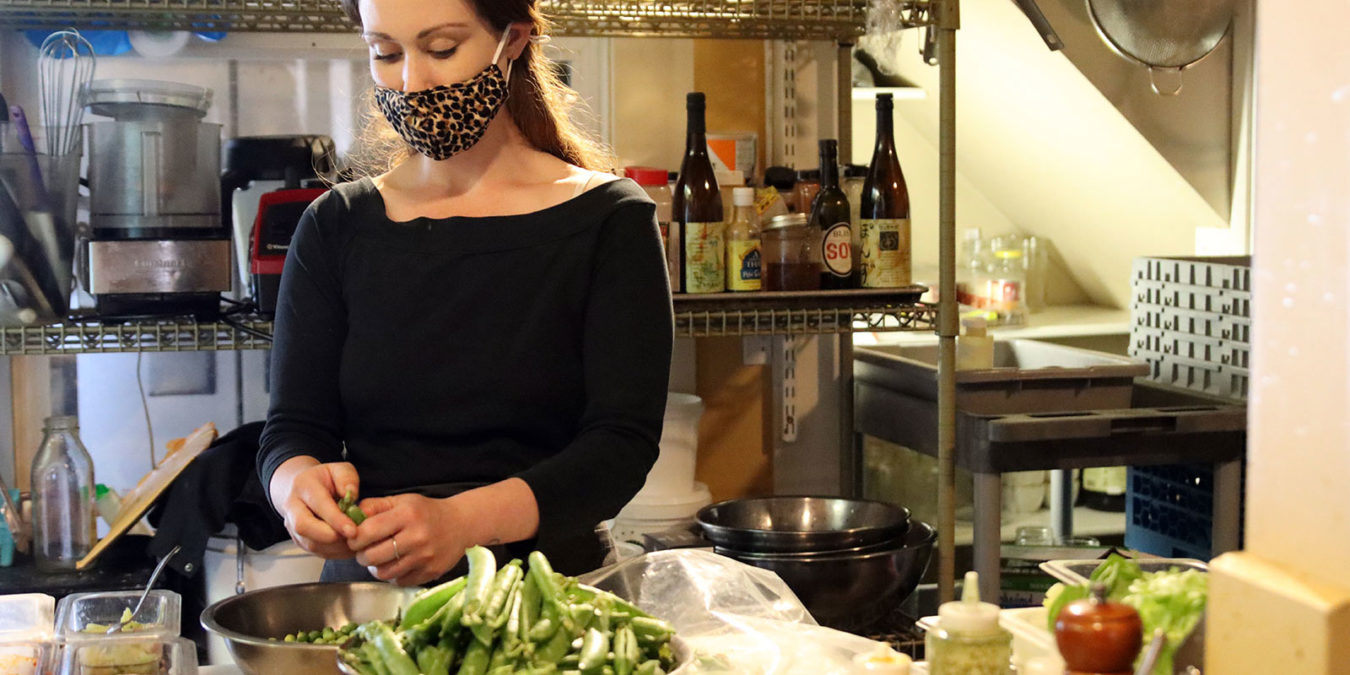In our Summer 2010 Coho Restaurant newsletter, we reported on Dave’s invitation to Oregon Pinot Camp. The organizers selected 270 lucky attendees from every state in the country as well as London, Hong Kong and Japan. From the cheesy grin on his face in this shot taken in the Sokol Blosser vineyards, it looks like Dave was enjoying the weekend immensely. To him it was like a fantastic summer camp – four days of eating, tasting, and participating in six different workshops. But we couldn’t let him get away with all play and no work. We put him to the test, to see what he learned about Pinot Noir.

The Mystique and Reality of Pinot Noir
The Oregon Pinot Camp website mentions “the mystique and reality” of Pinot Noir. I asked Dave to explain what exactly that means; turns out, he had quite a lot to say about that. Pinot Noir is actually a French varietal that’s been around for centuries; if you’ve heard of “burgundy,” then you’re ahead of most. Understand now, we’re not talking about the cheap jug wine that used to be available on the bottom shelf in the grocery store that we bought way back in the 60’s to mix with 7-up for wine cocktails. No, we’re talking the real deal, and all the images of idyllic French wine country and lush life that go along with it. But the reality is, Pinot Noir is a very difficult grape to grow. Winemakers have to watch it every step of the way, from when the flower blooms on the vines to managing the vineyard throughout the growing season, picking the grapes at just the right time, crushing, fermenting, and bottling. At any point along the way, the batch can go bad. Winemakers typically have great tools to control flavors, but since this particular grape is rarely blended, the grape itself has to be perfect. Of course, the obvious question is, why don’t they blend it? The answer, according to Dave, is because it has such a unique flavor profile – other varietals tend to overpower it or detract from the flavor of the Pinot Noir. It’s a tough grape to grow, but “when you get it right, it’s beautiful.” One Oregon winery, Sineann, flouts that tradition and produces an unusual red table wine that is predominately Pinot Noir using left over juice from the season’s vintage.
Pinot Noir in Oregon
You’ll find Pinot Noirs grown in California, but it wasn’t until the mid 1960’s when a group of pioneering winemakers planted Pinots in Willamette Valley (a small fraction of the Willamette Valley production is Pinot Gris, a white, cool-climate grape), which is why it’s rare to find vines more than 40 years old. Growing this varietal has become more like a science experiment than the bucolic wine-growing image of the French countryside. Varying clones, genetic mutations within the varietal, and pinots grafted onto different root stock are all means to make the vines less susceptible to diseases than the original vines brought over from Europe.
These mutations have developed into “New World Pinot Noir.” The flavor profile of older style Pinot Noir has sharp notes of tar, red and black fruits, and tends to be “edgy” in Dave’s words. New World style is more representative of a California Pinot Noir – more fruit forward, more sweetness, but a nice depth of flavor. Oregon Pinot Noir “is like taking a big bucket of crushed fruit and throwing it on hot asphalt.” Breathe it in and you’ll get the scent of hot tar, fruit but a lot of acidity, and some sharpness. This helps the wine hold up with food. It also muddies the distinction between “Old World” and “New World” since it is New World wine emulating Old World style.
The Growing Process
A highly sensitive grape, Pinot Noir needs lots of sunlight; most vineyards are planted on southern-facing slopes. The elevation above the valley floor determines how well it will do: 200 – 800 foot elevation is too low; the valley floor is cold and the grapes will freeze prematurely. They need the air flow of wind in higher elevations to keep condensation off the grapes. They also need just the right amount of rainfall – not too much, not too little, shades of Goldilocks!
During the growing season, workers will cut clusters off the vines to concentrate the fruit flavor and nutrients in the remaining clusters. The Pinot Noir grape is extremely sensitive to “terroir,” meaning it tastes of the land where it was grown, taking weather and vineyard management into account. This is particularly true of California-grown grapes where you can taste the same varietal from the same vineyard year to year and note flavor differences due to weather terroir. In Oregon, winemakers have now learned so much about the grape, they can achieve the level of flavor they are after and the profile doesn’t vary much from year to year.
The Pursuit of Perfection
So what entices winemakers to pursue this finicky grape? According to Dave, you have to be a bit of a masochist to even grown the darned grape, but really it’s the mystique that keeps them going. The winemakers share their knowledge with each other, which helps everyone succeed, and contributes to the favorable reputation of the Oregon products. Willamette Valley is the same latitude as Burgundy, France and has a similar climate. The grape thrives in Oregon. In fact, to the Pinot connoisseur, Oregon Pinots are widely recognized. Real burgundies are very expensive, but you can get a similar taste for a much better price with an Oregon Pinot.
Which begs the question, “What makes the perfect Pinot?” It should have a nice, appealing nose, a little tar, ripeness with red and black fruits, a hint of spice; it should hit your mouth with more fruit forward, and you should be able to taste the acidity and minerality. It needs a nice, long, lingering finish – a clean, soft, caressing, velvety taste that says, “please, I want another sip.” If the wine is well produced, it will release more aromas and flavors as it gets air; in fact, some actually taste better a day or two after the bottle has been opened, while others will lose their fruitiness if they’ve been oxidized too long.
After three days of tasting wines from 50 vendors, you would think one or two wines would stand out. But most of the wines are made at such a high level of quality that Dave was unable to single out any particular wine as being the best.
Interestingly, it was one educational tasting session that made the greatest impression on our intrepid sipper. He tasted the same wine, from the same year, one version bottled with a cork, one with a screw cap. The batch with the screw cap tasted the same as it did when bottled; the one with the cork had clearly aged – it lost fruit, but gained complexity. Which is preferable? That all depends on your palate, and whether you like mature wines or not. But if you’re not going to drink it for a few years, a screw cap makes a very worthy wine – and puts a real damper on wine snobbery! Clearly, wines with screw caps maintain the freshness of the wine.
Wine List Selections
With all this care and attention required for making Pinot Noir wine, you may be wondering if it’s even possible to buy an inexpensive one. That’s the trick – finding those values in the marketplace. The less expensive wines tend to be more fruity and don’t have the classic flavor profile; they’re still good, but the nose is not as aromatic, the finish is flat, and they just don’t have the depth. A reasonably good, entry level wine will run $20 to $30 a bottle; the higher-quality wines will be in the $60 range.
Asked if he plans to make any changes to the Coho Restaurant wine list as a result of attending Pinot Camp, Dave stated that the experience actually reinforced the decision he’d made with his original selections. Most Pinot Noirs on Coho’s list are already from Oregon, and often selections are driven by customer request, but he is always looking for something new, especially if it’s a good value. “That’s my goal – to find a reasonably-priced wine with GREAT taste!”
To follow news on our inns and around the island, check out www.harrisonhousesuites.com, www.tuckerhouse.com, and www.experiencesanjuanisland.com.

